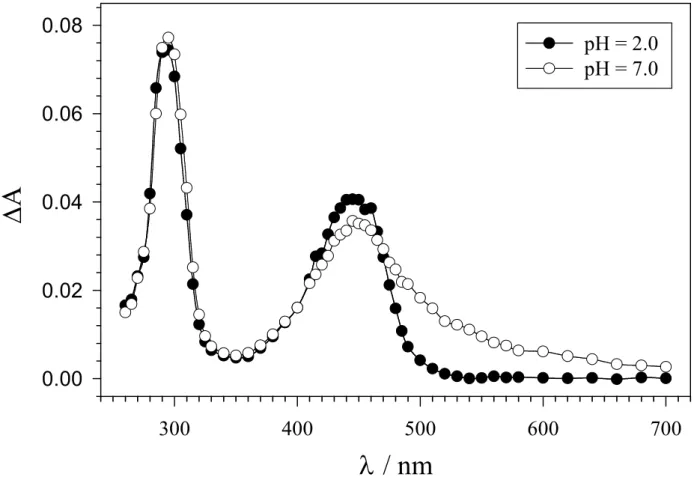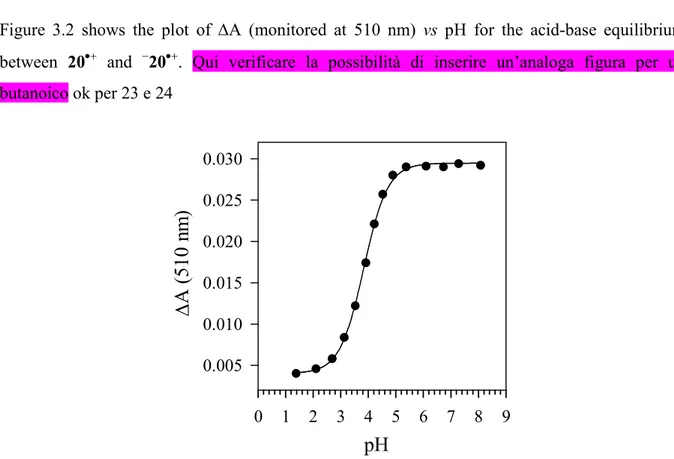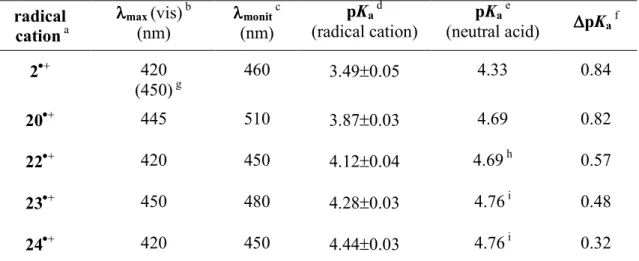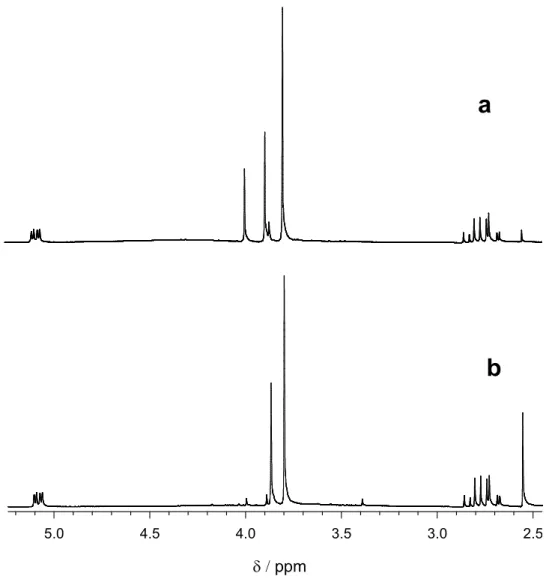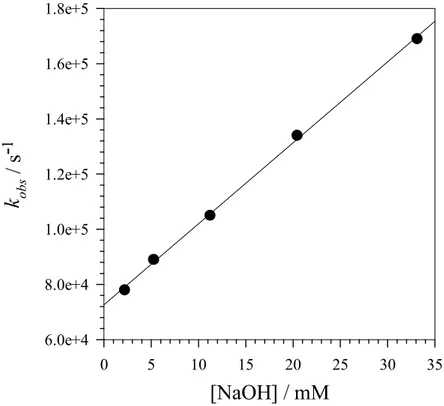CHAPTER 3
Reactivity and Acid-Base Behavior of Ring-Methoxylated Arylalkanoic Acid
Radical Cations and Radical Zwitterions in Aqueous Solution. The Influence
of Structural Effects and pH on the Benzylic C−
−
−H Deprotonation Pathway
−
Introduction
In chapter 2.1, we have shown that in aqueous solution the one-electron oxidation of ring-dimethoxylated phenylethanoic acids leads to the formation of aromatic radical cations or radical zwitterions depending on pH, providing moreover pKa values for their acid-base equilibria. The
radical cations were observed to undergo exclusive decarboxylation to give the corresponding benzyl radicals (as shown in Scheme 3.1 for 3,4-dimethoxyphenylethanoic acid radical cation (2•+)) with rate constants that are influenced by the substitution pattern of the aromatic ring, and a significant increase in decarboxylation rate constant was observed on going from the radical cations to the corresponding radical zwitterions.
CH2CO2H OCH3 OCH3 + CO2 + H+ CH2 OCH3 OCH3 2 Scheme 3.1
These results have been interpreted in terms of the reorganization energy required for the side-chain to ring intramolecular electron transfer associated to decarboxylation, which is influenced by the extent of stabilization of the positive charge on the aromatic ring and hence by the relative position of methoxy ring substituents. In this study, no evidence for the formation of products deriving from benzylic C−H deprotonation in the radical cations or in the radical zwitterions was obtained.
Along this line, in order to obtain more information on the role of structural effects on the acid-base behavior of arylalkanoic acid radical cations and on the possible competition between decarboxylation and benzylic C−H deprotonation, we have investigated the effect of the distance between the carboxylic group and the aromatic ring through a product and time-resolved kinetic study at different pH values on the reactivity of the radical cations generated after one-electron oxidation of 3-(4-methoxyphenyl)propanoic (20), 3-hydroxy-3-(4-methoxyphenyl)propanoic (21), 3-(3,4-dimethoxyphenyl)propanoic (22), 4-(4'-methoxyphenyl)butanoic (23) and 4-(3,4-dimethoxyphenyl)butanoic acid (24) (Chart 3.1).
OCH3 CH2CH2CH2CO2H OCH3 OCH3 CH2CH2CH2CO2H OCH3 CHCH2CO2H OH OCH3 CH2CH2CO2H OCH3 21 OCH3 CH2CH2CO2H OCH3 OCH3 CH2CO2H 20 22 2 23 24 Chart 3.1
Results and Discussion
Spectral properties and acid-base behavior. The transients produced after PR or LFP of acidic aqueous solutions (pH ≤ 2) containing substrates 20-24 showed UV and visible absorption bands centered around 290-310 and 420-450 nm which are analogous to those observed for the corresponding mono- and dimethoxylated aromatic radical cations,1-3 and are thus assigned to the arylalkanoic acid radical cations 20•+-24•+, formed by SO4•− or Tl2+ induced one-electron
oxidation of the neutral substrates as described in eq 3.1.
Ar(CH2)nCO2H + SO4 (Tl2+) Ar(CH2)nCO2H + SO42- (Tl+) (3.1) n = 2-3
By increasing the pH of the solution to ≈ 7, the spectra obtained after SO4•− induced one-electron
oxidation of acids 20-24 were similar to those obtained in acidic solution.4 However, as described previously for ring-methoxylated phenylethanoic acid radical cations (see Chapter 2.1), a broadening of the radical cation visible absorption band was observed. This behavior is attributed
time-resolved absorption spectra observed after 248 nm LFP of argon-saturated aqueous solutions containing 20 (1 mM) and K2S2O8 (0.1 M) at pH = 2.0 (filled circles) and pH = 7.0
(empty circles). A broadening of the visible absorption band is observed on going from 20•+ to
−
20•+. Identical spectra were obtained after PR of argon saturated aqueous solutions (pH = 2.0 and 7.3) containing K2S2O8 (5 mM), 2-methyl-2-propanol (0.1 M) and 20 (0.5 mM).
λ / nm
∆
A
300
400
500
600
700
0.00
0.02
0.04
0.06
0.08
pH = 2.0
pH = 7.0
Figure 3.1. Time-resolved absorption spectra observed after 248 nm LFP of argon-saturated aqueous solutions containing 0.1 M K2S2O8 and 1 mM 3-(4'-methoxyphenyl)propanoic acid (20),
recorded at pH = 2.0 (filled circles), and pH = 7.0 (empty circles), 1 µs after the 20 ns, 10 mJ laser flash.
By measuring the absorption at a suitable wavelength (where the difference in absorption between radical cation and radical zwitterion is sufficiently large) as a function of pH, the pKa
values for the acid-base equilibria between the radical cations and the corresponding radical zwitterions (eq 3.2) were determined.
Ar(CH2)nCO2H + H2O Ar(CH2)nCO2
-
(3.2) + H3O+ n = 2-3Figure 3.2 shows the plot of ∆A (monitored at 510 nm) vs pH for the acid-base equilibrium between 20•+ and −20•+. Qui verificare la possibilità di inserire un’analoga figura per un butanoico ok per 23 e 24 0 1 2 3 4 5 6 7 8 9 0.005 0.010 0.015 0.020 0.025 0.030
pH
∆
A
(
5
1
0
n
m
)
Figure 3.2. Plot of ∆A monitored at 510 nm vs pH for 20•+, generated after 248 nm LFP of an argon-saturated aqueous solution containing 0.1 M K2S2O8 and 1 mM 16. From the curve fit: pKa
= 3.84±0.02 (r = 0.9995).
The pKa values thus obtained for 20•+-24•+ are collected in Table 3.1 together with the radical
cation visible absorption band maxima and the pKa values of the neutral acids 20-24. As a matter
of comparison, the corresponding data for 3,4-dimethoxyphenylethanoic acid (2) and for its radical cation (2•+) are also included (see Chapter 2.1).
Table 3.1. Visible absorption band maxima for radical cations 20, 22•+-24•+ and corresponding pKa values for their acid-base equilibria, measured at room
temperature. radical cation a λ λλ λmax (vis) b (nm) λ λλ λmonit c (nm) pKa d (radical cation) pKa e (neutral acid) ∆∆∆∆pKa f 2•+ 420 (450) g 460 3.49±0.05 4.33 0.84 20•+ 445 510 3.87±0.03 4.69 0.82 22•+ 420 450 4.12±0.04 4.69 h 0.57 23•+ 450 480 4.28±0.03 4.76 i 0.48 24•+ 420 450 4.44±0.03 4.76 i 0.32 a
Generated by 248 nm LFP as described above (eqs 8 and 9). bRadical cation visible absorption band maxima. cMonitoring wavelength for pKa determination. dBased on
the average of at least two independent measurements. eTaken from ref. 7. f∆pKa =
pKa (neutral acid) − pKa (radical cation). gVisible absorption band maximum for the
corresponding radical zwitterion −2•+. hThis value refers to 3-(4'-methoxyphenyl)propanoic acid (20). However, on the basis of the very similar pKa
values measured for 20 and for 3-phenylpropanoic acid (pKa = 4.69 and 4.66,
respectively), and for 4-methoxyphenylethanoic acid (1) and 3,4-dimethoxyphenylethanoic acid (2) (pKa = 4.36 and 4.33, respectively) the same pKa
value (pKa = 4.69) can be reasonably assumed for 20 and 22. i This value refers to
4-phenylbutanoic acid. However, on the basis of the considerations outlined in footnote h above, the same pKa value (pKa = 4.76) can be reasonably assumed also for 23 and
24.
With 3,4-dimethoxyphenylethanoic acid (2) the increase in acidity of the carboxylic proton observed on going from the neutral substrate (pKa = 4.33) to the corresponding radical cation 2•+
(pKa = 3.49) has been rationalized in terms of the increased electron withdrawing effect
determined by the presence of an electron hole on the aromatic ring. Along this line, the observation that in the ring dimethoxylated arylalkanoic acid series the radical cation pKa value
increases on going from 2•+ to 24•+ can be explained analogously in terms of a decrease in the electron withdrawing effect as the distance between the carboxylic group and the electron deficient aromatic ring increases. Accordingly, on the basis of the pKa values available for the
neutral substrates: 4.33 for 2, 4.69 for 22, and 4.76 for 24 (see Table 3.1), the difference in pKa
between the neutral substrates and the corresponding radical cations (∆pKa) decreases
respectively. Quite interestingly the ∆pKa value obtained for 24/24•+ shows that even though
small, an effect on acidity is still present when the positively charged aromatic ring is in the γ position with respect to the carboxylic function. As a matter of comparison, a similar effect on acidity has been also observed when comparing butanoic acid (pKa = 4.82) with 4-chlorobutanoic
acid (pKa = 4.52).8
A slight decrease in acidity is also observed on going from the monomethoxylated radical cations to the dimethoxylated ones (compare 20•+ with 22•+ and 23•+ with 24•+), a behavior that reasonably reflects the fact that the presence of two methoxy ring substituents as in 22•+ and 24•+ allows a greater extent of positive charge stabilization as compared to 20•+ and 23•+, resulting in a weaker electron withdrawing effect.
Product studies. The oxidation reactions of substrates 20-24 were carried out in argon saturated aqueous solution (pH = 1.7 or 6.7) at room temperature, employing SO4•− as the oxidant,
generated by steady state 254 nm photolysis as described in eq 1.3. Irradiation times were chosen in such a way as to avoid complete substrate consumption. In some experiments, potassium 12-tungstocobalt(III)ate (Co(III)W) was used as the oxidant.
After workup, the reaction mixtures were analyzed by 1H NMR using diphenylmethanol as internal standard and the reaction products were generally identified by comparison with authentic samples.
At pH = 1.7 the reaction of 20 led to a 60 % substrate conversion after 1.5 min of irradiation (mass balance > 99 %). Formation of 3-hydroxy-3-(4'-methoxyphenyl)propanoic acid (21), was observed accompanied by a small amount (≈ 2 % of the reaction products) of 4-methoxyacetophenone (Scheme 3.2).9 An analogous product distribution was observed when the irradiation was carried out at pH = 6.7.
OCH3 CH2CH2CO2H 98 % 2 % + K2S2O8 (pH = 1.7) hν (254 nm) OCH3 CHCH2CO2H OH 20 21 OCH3 CCH3 O Scheme 3.2
The formation of 21 can be explained in terms of benzylic C−H deprotonation of the radical cation 20•+ (generated by SO4•− induced oxidation of 20 as described in eq. 3.1) to give a
substituted benzyl radical. Oxidation of this radical in the reaction medium followed by reaction with the solvent water leads to 21, as shown in Scheme 3.3, in line with the deprotonation reactions of a variety of alkylaromatic radical cations described previously.10-16
OCH3 CH2CH2CO2H OCH3 CHCH2CO2H 20 21 SO4 OCH3 CH2CH2CO2H OCH3 CHCH2CO2H OH 1) ox 2) H2O, - H+
-
H+ 20 Scheme 3.3The formation of 4-methoxyacetophenone in small amount can be instead explained in terms of the further oxidation of the first formed β-hydroxy acid 21 (see below).
Quite interestingly, previous studies carried out on 3-phenylpropanoic acid radical cation showed the formation of products deriving from both the decarboxylation and benzylic C−H deprotonation pathways.17-19 In particular, by means of product studies Walling observed the formation of styrene, ethylbenzene, β-phenylethyl acetate, phenylacetaldehyde and 2-chromanone as major reaction products after one-electron oxidation of 3-phenylpropanoic acid in acetic acid and acetonitrile.19 It was proposed that styrene, ethylbenzene, β-phenylethyl acetate and phenylacetaldehyde derive from the decarboxylation of the first formed radical cation,20 whereas 2-chromanone derives from the C−H deprotonation pathway.21 Gilbert carried out instead an EPR study at different pH values on the one-electron oxidation of 3-phenylpropanoic acid promoted by •OH or SO4•−.17,18 The signals deriving from the C−H deprotonated benzylic
radical (PhCH•CH2CO2H) were observed at pH < 1.8 with •OH and < 1.5 with SO4•−. Above
these pH values, these signals were replaced in both cases by those assigned to the decarboxylated radical PhCH2CH2•. This behavior was explained in terms of the formation of an
path a) or intramolecular electron transfer from the carboxyl group to the ring (either direct (path b) or via formation of a discrete σ-bonded cyclic intermediate (paths c-d)) to give an acyloxyl radical, precursor of the decarboxylated radical PhCH2CH2• (path e).
CHCH2CO2H CH2CH2CO2H
-
H+ a O O-
H+ + H+-
H+ b CH2CH2CO2-
CO2 CH2CH2 c d e Scheme 3.4According to this picture, the observation that 20•+ undergoes instead exclusive benzylic C−H deprotonation at both pH 1.7 and 6.7 can be rationalized in terms of the increased stability of 20•+ as compared to 3-phenylpropanoic acid radical cation determined by the presence of a methoxy ring-substituent. This increased stabilization of the positive charge on the aromatic ring results in an increase of the energy barrier for the intramolecular electron transfer step (Scheme 3.4, path b or c-d) thus disfavoring the formation of the intermediate acyloxyl radical and hence of the products deriving from the decarboxylation pathway.
At pH = 1.7 the reaction of 21 led to a 35 % substrate conversion after 30 s of irradiation (mass balance > 99 %). Formation of 3-oxo-3-(4'-methoxyphenyl)propanoic acid (21k) as the major reaction product, accompanied by 4-methoxyacetophenone was observed. The 1H NMR analysis of the reaction mixture showed a decrease in the amount of 21k on standing at room temperature, accompanied by a corresponding increase in the amount of 4-methoxyacetophenone.
In particular, the 1H NMR spectrum recorded immediately after workup of the reaction mixture (Figure 3.3, spectrum a, showing the 2.5-5.2 ppm range) shows the presence of the substrate 21 (65 %: characterized by the double doublet at 5.09 ppm, the singlet at 3.79 ppm and the multiplet
at 2.77 ppm) accompanied by 21k (33 %: characterized by the singlets at 4.00 and 3.89 ppm) and 4-methoxyacetophenone (2 %: characterized by the singlets at 3.87 and 2.55 ppm). The 1H NMR spectrum recorded after heating the same sample for 1 hour at T = 50 °C (Figure 3.3, spectrum b) shows in addition to the signals due to 21 the almost complete disappearance of the signals due to 21k (2 %), accompanied by an increase in intensity of the signals due to 4-metoxyacetophenone (33 %). 2.5 3.0 3.5 4.0 4.5 5.0 δ / ppm
a
b
Figure 3.3. 1H NMR spectra recorded in CDCl3 after 254 nm steady state photolysis of an
aqueous solution (pH = 1.7) containing 2 mM 3-hydroxy-3-(4'-methoxyphenyl)propanoic acid (21) and 0.1 M K2S2O8. a) Spectrum recorded immediately after workup of the reaction mixture.
b) Spectrum recorded on the same solution as in a after heating for 1 hour at T = 50 °C.
This behavior strongly suggests that 4-methoxyacetophenone derives from the spontaneous decarboxylation of the first formed β-keto acid 21k, as described in Scheme 3.5, in full
agreement with the reported decarboxylation kinetics of 21k (in aqueous solution at T = 35.6 °C, τ = 1930 s).23 OCH3 CHCH2CO2H OH K2S2O8 (pH = 1.7) hν (254 nm) OCH3 CCH2CO2H O 21 20k OCH3 CCH3 O CO2 Scheme 3.5
An analogous behavior was observed when 21 was irradiated at pH = 6.7 even though, as compared to the reaction carried out at pH = 1.7, a significantly higher substrate conversion was observed (85 % after 30 s irradiation).
The formation of 21k after one-electron oxidation of 21 can be explained in terms of C−H deprotonation of the radical cation 21•+ (generated by SO4•− induced oxidation of 21 as described
in eq. 3.1) to give a substituted α-hydroxy benzyl radical. Oxidation of this radical in the reaction medium followed by deprotonation leads to 21k, as shown in Scheme 3.6, in line with the deprotonation reactions of a variety of 1-arylalkanol radical cations described previously.1,10,24-26
OCH3 CHCH2CO2H OH OCH3 CCH2CO2H OH 21 20k SO4 OCH3 CHCH2CO2H OH OCH3 CCH2CO2H O 1) ox 2) - H+
-
H+ 21 Scheme 3.6At pH = 1.7 the reaction of 23 led to a 60 % substrate conversion after 1.5 min of irradiation (mass balance > 99 %). The exclusive formation of 5-(4'-methoxyphenyl)oxa-2-cyclopentanone (23c) was observed. Formation of the same product was also observed when the oxidation of 23
was carried out at pH = 1.7 or 6.7 employing Co(III)W (Scheme 3.7: Ar = 4-MeOC6H4, ox = hν/K2S2O8 or Co(III)W). 23: Ar = 4-MeOC6H4 24: Ar = 3,4-(MeO)2C6H3 ArCH2CH2CH2CO2H O Ar O ox 23c 24c Scheme 3.7
The formation of 23c following one-electron oxidation of 23 can be explained in terms of C−H deprotonation of the radical cation 23•+ to give a substituted benzyl radical. Oxidation of this radical in the reaction medium followed by intramolecular nucleophilic attack leads to 23c, (Scheme 3.8, Ar = 4-MeOC6H4), as described previously for the one-electron oxidation of
4-phenylbutanoic acid.27-29 23 : Ar = 4-MeOC6H4 24 : Ar = 3,4-(MeO)2C6H3 ArCH2CH2CH2CO2H O Ar O
-
H+ ArCHCH2CH2CO2H ox ArCHCH2CH2CO2H-
H+ 23c 24c Scheme 3.8At pH = 1.7, 1.5 min irradiation of the ring-dimethoxylated acids 22 and 24 in the presence of K2S2O8 resulted in both cases in an almost quantitative (≥ 95 %) recovery of the parent
compound. No oxidation products were detected under these conditions. The reactions of 22 and 24 were thus carried out employing Co(III)W as the oxidant.
The reaction of 22 with Co(III)W was carried out only at pH = 1.7 and the exclusive formation of 3-hydroxy-3-(3',4'-dimethoxyphenyl)propanoic acid (22a) (see for analogy Scheme 3.2 describing the reaction of 20) was observed. Formation of 22a can be explained in terms of C−H deprotonation of the radical cation 22•+ as described in Scheme 3.3 for the oxidation of 20. The reaction of 24 with Co(III)W was carried out at pH = 1.7 and 6.7. In both cases the exclusive formation of 5-(3',4'-dimethoxyphenyl)oxa-2-cyclopentanone (24c) was observed (Scheme 3.7:
Ar = 3,4-(MeO)2C6H3, ox = Co(III)W). Formation of 24c can be explained in terms of C−H
deprotonation of 24•+ (Scheme 3.8: Ar = 3,4-(MeO)2C6H3, ox = Co(III)W), as discussed above
for the corresponding reaction of 23. Time-resolved kinetic studies.
Acidic solution (pH ≈ 1.7). The decay rates of the radical cations 20•+-24•+ were measured spectrophotometrically following the decrease in optical density at the visible absorption band maxima (between 420 and 450 nm). With 20•+, 21•+ and 23•+ the decay was observed to follow first order kinetics, in a reaction that, on the basis of the product analysis results described above, is assigned to benzylic C−H deprotonation.
The decay of radical cations 22•+ and 24•+ was instead observed to be influenced by the radiation chemical dose or laser intensity and accordingly, only an upper limit for their decay rate constant could be determined. Also the decay of 22•+ and 24•+ is assigned to benzylic C−H deprotonation on the basis of the product analysis results described above. The rate constants thus obtained are collected in Table 3.2.
Table 3.2. First order rate constants (k) measured following the decay of radical cations 20•+-24•+ generated by PR or LFP of the parent substrates in aqueous solution (pH ≈ 1.7), measured at T = 25 °C.
radical cation oxidant k / s−1 a
20•+ Tl +2 b SO4•− c 1.5 × 103 1.8 × 103 21•+ SO4•− c 6.5 × 103 22•+ Tl +2 b SO4•− c < 5 × 102 < 50 23•+ Tl +2 b SO4•− c 1.7 × 103 2.1 × 103 24•+ Tl +2 b SO4•− c < 5 × 102 < 50 a
Monitored following the decay of absorption at the radical cation visible absorption band maxima (between 420 and 450 nm). Error ≤ 10%. bGenerated by PR (dose ≤ 1 Gy/pulse) of N2O saturated
aqueous solutions containing the substrate (0.5 mM) and Tl2SO4
(2.0 mM) as described in eqs 1.4, 1.7-1.9. cGenerated by LFP of argon saturated aqueous solutions containing the substrate (0.1-1.0 mM) and K2S2O8 (0.1 M) as described in eqs 1.2 and 1.3.
Quite interestingly, the rate constants measured for 20•+ and 23•+ and for 21•+ are very similar to those measured previously in acidic aqueous solution for benzylic C−H deprotonation of the structurally related radical cations 4-MeOC6H4(CH2)3OH•+ and 4-MeOC6H4(CH2)4OH•+ (k = 1.8
× 103 and 1.4 × 103 s−1, respectively),30 and for 4-MeOC6H4CH(OH)CH2CH3•+ (k = 5.4 × 103
s−1).25 The similarity of these values provides additional support to the assignement of the rate constants displayed in Table 3.2 to the benzylic C−H deprotonation reaction. For what concerns instead the dimethoxylated radical cations 22•+ and 24•+, even though due to instrumental limits only an upper limit for their deprotonation rate constants could be determined, the limits reported in Table 2 (k < 50 s−1) can be reasonably compared with the rate constant obtained for α-C−H deprotonation of 3,4-dimethoxybenzylalcohol radical cation (k = 17 s−1). As discussed previously for alkylaromatic radical cations,1,11,12,24 stabilization of the radical cation (that is on going from the monomethoxylated radical cations 20•+ and 23•+ to the corresponding dimethoxylated ones 22•+ and 24•+) leads to a significant decrease in the deprotonation rate constant.
Basic solution (pH > 10). By monitoring the decay of radical zwitterions −2•+, −20•+, −22•+, −23•+ and −24•+ at the visible absorption band maxima (between 420 and 450 nm) a significant increase in rate was observed when −OH was added to the solution, and by plotting the observed rates (kobs) vs concentration of added base, a linear dependence was observed for all radical zwitterions
[NaOH] / mM
0 5 10 15 20 25 30 35k
ob s/
s
-1 6.0e+4 8.0e+4 1.0e+5 1.2e+5 1.4e+5 1.6e+5 1.8e+5Figure 3.4. Plot of kobs against concentration of NaOH for the reaction of radical zwitterion −2•+.
From the linear regression analysis: intercept = 7.2 × 104 s−1, slope = 2.9 × 106 M−1 s−1, r2 = 0.9991.
From the slopes of these plots, the second-order rate constants for reaction of −OH with the radical zwitterions (k−OH) were determined. The rate constants thus obtained are collected in
Table 3.3.
Table 3.3. Second-order rate constants for the − OH-catalyzed (k−OH) decay of radical zwitterions −2•+, −20•+, −
22•+-−24•+ generated by pulse radiolysis of the parent substrates in aqueous solution, measured at T = 25 °C.
radical zwitterion a pH range b k−−−−OH c (M−1 s−1) − 2•+ 11.3-12.6 2.9 × 106 − 20•+ 10.3-11.4 2.8 × 107 − 22•+ 11.2-12.5 9.0 × 105 − 23•+ 10.3-11.4 4.4 × 107 − 24•+ 11.2-12.5 8.5 × 105
a
The radical zwitterions were generated by PR (dose ≤ 5 Gy/pulse) of an argon saturated aqueous solution containing the substrate (0.5-1.0 mM), K2S2O8 (10 mM),
2-methyl-2-propanol (0.1 M) and Na2B4O7 (1 mM) as
described in eqs 1.2 and 1.4-1.6. bpH range employed for the determination of k−OH. cObtained from the slopes of the
kobs vs [NaOH] plots, where kobs has been obtained from the
decay of absorption at the radical zwitterion visible absorption band maxima (between 420 and 450 nm). Average of at least two independent determinations. Error ≤ 10%.
The data collected in Table 3.3 show that very similar second-order rate constants k−OH have been
obtained for the monomethoxylated radical zwitterions −20•+ and −23•+, as well as for the dimethoxylated ones −22•+ and −24•+. These values are similar to those determined previously for the −OH-induced α-C−H deprotonation of 4-methoxytoluene and 3,4-dimethoxytoluene radical cations (k−OH = 5.5 × 107 and 2.1 × 106 M−1 s−1, respectively),2c and can be thus assigned to the
same process i.e. −OH-induced benzylic C−H deprotonation in −20•+-−24•+.
With −2•+ the second-order rate constant for reaction with −OH has been determined as k−OH = 2.9
× 106 M−1 s−1, a value that is very similar to the one determined previously for the −OH-induced α-C−H deprotonation of 3,4-dimethoxytoluene radical cation discussed above.2c Quite importantly, the intercept of the kobs against [NaOH] plot (7.2 × 104 s−1, see Figure 4), that
represents the rate constant for the uncatalyzed reaction of −2•+, is very close to the decarboxylation rate constant measured previously for this radical zwitterion between pH 6 and 10 (k = 6.5 × 104 s−1).32 On the basis of these observations it is reasonable to propose that above pH 11 −2•+ undergoes competition between benzylic C−H deprotonation and decarboxylation, with the former process that becomes the major fragmentation pathway around pH 12.5.
In conclusion, by means of product and time-resolved studies additional information on the acid-base behavior and side-chain fragmentation reactivity of ring-methoxylated arylpropanoic and arylbutanoic acid radical cations and radical zwitterions in aqueous solution have been obtained. The radical cation pKa values increase by increasing the number of methoxy ring substituents and
by increasing the distance between the carboxylic group and the aromatic ring. The radical cations or radical zwitterions undergo benzylic C−H deprotonation as the exclusive side-chain fragmentation pathway over the pH range 1.7-12.5. Very interestingly, with 3,4-dimethoxyphenylethanoic acid radical zwitterion, that was previously observed to undergo
decarboxylation as the exclusive fragmentation pathway up to pH 10, competition between decarboxylation and benzylic C−H deprotonation is observed above pH 11.
References
(1) Baciocchi, E.; Bietti, M.; Gerini, M. F.; Manduchi, L.; Salamone, M.; Steenken, S. Chem. Eur. J. 2001, 7, 1408-1416.
(2) O’Neill, P.; Steenken, S.; Schulte-Frohlinde, D. J. Phys. Chem. 1975, 79, 2773-2779.
(3) 21•+ was generated exclusively by 266 nm LFP of an argon saturated aqueous solutions (pH = 1.7 or 6.6) containing 21 (1.0 mM) and K2S2O8 (0.1 M), and showed in both cases UV and
visible absorption bands centered at 290 and 445 nm.
(4) It is important to point out that at pH ≈ 7 one-electron oxidation occurs on the deprotonated acids and not on the neutral substrates 20-24. However, on the basis of the spectroscopic evidences presented, that are indicative of the formation of aromatic radical zwitterions under these conditions, the direct oxidation of the carboxylate function to give an acyloxyl radical can be excluded. In addition, as it is well known that acyloxyl radicals undergo very rapid decarboxylation (see for example ref. 5), also the lack of decarboxylation products observed after one-electron oxidation of the acids at pH ≈ 7 (see the product studies described below) points against direct one-electron oxidation of the carboxylate function.
(5) Bockman, T. M.; Hubig, S. M.; Kochi, J. K. J. Org. Chem. 1997, 62, 2210-2221.
(6) This notation represents an oversimplification because, as compared to the radical cations, the corresponding radical zwitterions lack the presence of the carboxylic proton.
(7) Kortüm, G.; Vogel, W.; Andrussow, K. Dissociation Constants of Organic Acids in Aqueous Solution; Butterworths: London, 1961.
(8) Streitwieser, A.; Heathcock, C. H.; Kosower, E. M. Introduction to Organic Chemistry 4th Ed.; Prentice Hall: Upper Saddle River, 1998.
(9) It is important to point out that when the reaction mixture of 20 was analyzed by GC and GC-MS, the formation of 4-methoxystyrene as major product, accompanied by smaller amounts of 4-methoxybenzaldehyde, 4-methoxyacetophenone and 4-methoxyphenylacetaldehyde was observed. No evidence for the formation of hydroxy acid 21 was instead obtained. A similar outcome was also observed when an authentic sample of 21 was analyzed by GC and GC-MS. Accordingly, the formation of the products described above from the reaction mixture of
20 under these analytical conditions can be reasonably explained in terms of the thermal decomposition of the first formed 21.
(10) Baciocchi, E.; Bietti, M.; Ercolani, G.; Steenken, S. Tetrahedron 2003, 59, 613-618. (11) Baciocchi, E.; Del Giacco, T.; Elisei, F. J. Am. Chem. Soc. 1993, 115, 12290-12295. (12) Russo-Caia, C.; Steenken, S. Phys. Chem. Chem. Phys. 2002, 4, 1478-1485.
(13) (a) Parker, V. D.; Lu, Y.; Zhao, Y.J. Org. Chem. 2005, 70, 1350-1355. (b) Lu, Y.; Zhao, Y.; Parker, V. D. J. Am. Chem. Soc. 2001, 123, 5900-5907. (c) Parker, V. D.; Zhao, Y.; Lu, Y.; Zheng, G. J. Am. Chem. Soc. 1998, 120, 12720-12727. (d) Parker, V. D.; Chao, Y. T.; Zheng, G. J. Am. Chem. Soc. 1997, 119, 11390-11394.
(14) Amatore, C.; Kochi, J. K. Advances in Electron Transfer Chemistry 1991, 1, 55-148. (15) Freccero, M.; Pratt, A.; Albini, A.; Long, C. J. Am. Chem. Soc. 1998, 120, 284-297.
(16) (a) Tolbert, L. M.; Li, Z. Z.; Sirimanne, S. R.; VanDerveer, D. G. J. Org. Chem. 1997, 62, 3927-3930. (b) Tolbert, L. M.; Khanna, R. K.; Popp, A. E.; Gelbaum, L.; Bottomley, L. A. J. Am. Chem. Soc. 1990, 112, 2373-2378.
(17) Gilbert, B. C.; Scarratt, C. J.; Thomas, C. B.; Young, J. J. Chem. Soc., Perkin Trans. 2 1987, 371-380.
(18) Davies, M. J.; Gilbert, B. C.; McCleland, C. W.; Thomas, C. B.; Young, J. J. Chem. Soc., Chem. Commun. 1984, 966-967.
(19) Walling, C.; El-Taliawi, G. M.; Amarnath, K. J. Am. Chem. Soc. 1984, 106, 7573-7578. (20) In this work, the reaction products have been determined by GC. However, as described
above for 20, it cannot be excluded that a different product distribution would have been observed by 1H NMR analysis of the reaction mixture.
(21) However, 2-chromanone could also be formed following different reactive pathways in the radical cation, not involving direct benzylic C−H deprotonation (see for example ref. 22). (22) Taylor, E. C.; Andrade, J. G.; Rall, G. J. H.; Turchi, I. J.; Steliou, K.; Jagdmann, Jr., G. E.;
McKillop, A. J. Am. Chem. Soc. 1981, 103, 6856-6863. (23) Hay, R. W.; Tate, K. R. Aust. J. Chem. 1970, 23, 1407-1413.
(24) Baciocchi, E.; Bietti, M.; Lanzalunga, O. Acc. Chem. Res. 2000, 33, 243-251. (25) Baciocchi, E.; Bietti, M.; Steenken, S. Chem. Eur. J. 1999, 5, 1785-1793.
(26) Baciocchi, E.; Bietti, M.; Putignani, L.; Steenken, S. J. Am. Chem. Soc. 1996, 118, 5952-5960.
(28) (a) Giordano, C.; Belli, A.; Citterio, A.; Minisci, F. J. Chem. Soc., Perkin Trans. 1 1981, 1574-1576. (b) Giordano, C.; Belli, A.; Citterio, A. J. Org. Chem. 1980, 45, 345-346.
(29) Dessau, R. M.; Heiba, E. I. J. Org. Chem. 1975, 40, 3647-3649.
(30) Baciocchi, E.; Bietti, M.; Manduchi, L.; Steenken, S. J. Am. Chem. Soc. 1999, 121, 6624-6629.
